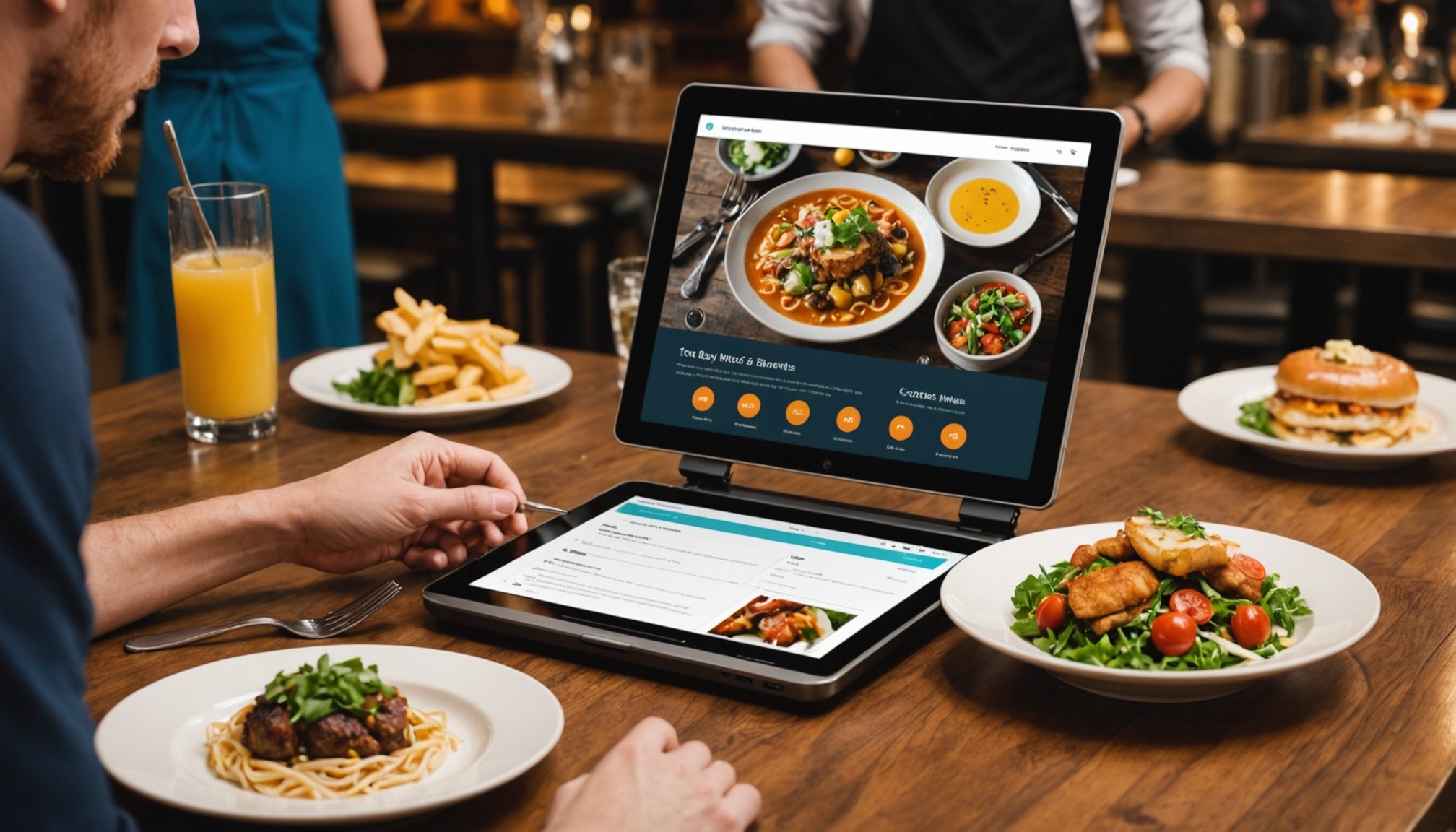Transforming Menus with AI: Top Strategies for UK Restaurants to Boost Culinary Creativity
In the ever-evolving landscape of the restaurant industry, the integration of artificial intelligence (AI) is revolutionizing how menus are designed, optimized, and presented to customers. For UK restaurants looking to stay ahead of the curve, embracing AI can be a game-changer. Here’s a deep dive into the top strategies for transforming menus with AI, enhancing culinary creativity, and improving the overall dining experience.
Personalized Menu Recommendations
One of the most compelling ways AI is transforming menus is through personalized recommendations. AI menu generators, powered by sophisticated algorithms, can analyze customer data to suggest menu items that align with individual preferences and dietary needs.
Topic to read : Greening UK Manufacturing: Essential Strategies for Sustainable Production Practices
How It Works
- Data Collection: AI tools collect data from various sources, including customer orders, feedback forms, social media interactions, and online reviews. This data helps identify patterns such as popular dishes, customer favorites, and emerging food trends[2][3][4].
- Analysis and Insights: Advanced algorithms analyze the collected data to provide insights into customer behavior and preferences. For instance, if a customer frequently orders vegetarian dishes, the AI can suggest new vegetarian options or special promotions[2][3].
- Menu Design: Based on the insights gained, AI menu generators recommend menu updates, including new dishes, seasonal specials, and limited-time offerings. These recommendations are designed to enhance the dining experience and foster customer loyalty[2].
Real-World Example
Taste Haven, a restaurant chain, implemented an AI menu generator to streamline its menu creation process. By analyzing customer data, the AI identified popular dishes and trending ingredients, leading to the introduction of new menu items that resonated well with customers. This resulted in enhanced personalization, greater efficiency in menu updates, and increased revenue[2].
Dynamic Pricing and Inventory Management
AI can significantly impact a restaurant’s profitability by optimizing pricing strategies and managing inventory more effectively.
Also to read : Revolutionizing UK Farming: Harnessing IoT to Boost Crop Monitoring
Dynamic Pricing
AI menu generators can adjust menu prices in real-time based on factors such as demand, seasonality, and inventory levels. This dynamic pricing allows restaurants to maximize revenue, minimize waste, and respond swiftly to changing market conditions. For example, a restaurant can increase prices during peak hours or offer discounts during quieter times to attract more patrons[2][3].
Inventory Management
AI-powered systems can monitor inventory levels and predict when ingredients are about to expire or run out. This ensures that the kitchen is always stocked with the necessary ingredients, reducing food waste and optimizing supply chain logistics. Here’s how it can be implemented:
- Real-Time Monitoring: AI systems track inventory levels in real-time, alerting staff when ingredients need to be restocked.
- Predictive Analytics: Advanced algorithms predict demand and adjust inventory accordingly, ensuring that the restaurant is always prepared for customer orders[3][5].
Enhancing Profitability and Efficiency
AI can drive profitability and efficiency in several key areas of restaurant operations.
Menu Optimization
AI tools can optimize menu layouts, pricing strategies, and item placement to maximize sales and reduce waste. Here are some ways AI can enhance profitability:
- High-Margin Items: AI can highlight high-margin items on the menu, encouraging customers to order these dishes and increasing overall revenue.
- Upselling Strategies: AI can suggest complementary dishes or promotions that increase the average order value without compromising customer satisfaction[2][3].
Automation of Routine Tasks
AI can automate routine tasks such as order processing, customer service, and inventory management, allowing restaurant staff to focus on more critical aspects of the business.
| Area of Operation | Traditional Method | AI-Driven Method |
|
|-------------------------------------|
|
| Menu Creation | Manual updates based on intuition | Data-driven updates using customer data |
| Pricing | Static pricing | Dynamic pricing based on demand and seasonality |
| Inventory Management | Manual tracking | Real-time monitoring and predictive analytics |
| Customer Service | Human interaction | AI-powered chatbots and voice generators |
| Order Processing | Manual order taking | Automated order processing with real-time updates |
Improving Customer Experience
AI is not just about efficiency and profitability; it also plays a crucial role in enhancing the customer experience.
Personalized Offers and Rewards
AI can customize special offers and reward programs for every customer. For instance, if a customer frequently orders a particular dish, the AI system can offer them a discount on their next order of that dish. This level of personalization increases customer loyalty and satisfaction[3].
Voice-Based Interactions
Integrating AI-powered voice generators can make the dining experience more interactive and accessible. Customers can receive voice-based recommendations and navigate the menu more easily, enhancing their overall dining experience[2].
Addressing Industry Challenges
The restaurant industry faces several challenges, including labor shortages, food waste, and the need for consistent quality. AI can address these challenges in several ways.
Labor Shortages
AI and robotics can automate repetitive tasks such as food preparation, reducing the workload on human staff. For example, Circus SE has introduced fully autonomous food service robots that use AI to prepare fresh meals personalized to individual needs, from preparation to serving[1].
Food Waste Reduction
AI can help reduce food waste by optimizing inventory management and predicting demand. By analyzing data on ingredient usage and expiration dates, AI systems can ensure that ingredients are used before they expire, reducing waste and saving costs[3][5].
Integrating AI into Restaurant POS Systems
AI is revolutionizing restaurant POS systems, making them more efficient, customer-centric, and profitable.
Real-Time Insights
AI-powered POS systems can provide real-time insights into customer behavior, allowing restaurants to make data-driven decisions. For instance, AI can analyze sales data to identify peak times and adjust pricing accordingly, ensuring maximum profitability[3].
Fraud Detection and Security
AI can monitor sales transactions in real-time, detecting unusual activity that could indicate fraud. This enhances security and protects the restaurant from potential financial losses[3].
Case Studies and Practical Insights
To illustrate the practical application of AI in menu transformation, let’s look at a couple of case studies and derive some actionable advice.
Urban Eats Restaurant
Urban Eats implemented an AI menu generator to automate the menu creation process. The AI collected data from customer orders, feedback forms, and online reviews to identify patterns and trends. Based on these insights, the AI suggested new dishes, seasonal specials, and limited-time offerings. This resulted in menu innovation, greater efficiency in updating menu offerings, and positive customer feedback[2].
Actionable Advice
- Start Small: Begin by integrating AI into one aspect of your operations, such as menu creation or inventory management, and gradually expand to other areas.
- Use Data Wisely: Leverage customer data to make informed decisions about menu design, pricing, and promotions.
- Stay Updated: Keep an eye on the latest AI advancements and technological trends in the food industry to remain competitive.
- Focus on Customer Experience: Use AI to personalize the dining experience, offering customized recommendations and rewards that enhance customer satisfaction and loyalty.
The Future of AI in the Food Industry
As AI continues to evolve, its impact on the food industry is expected to grow significantly.
Predictive Analytics and Machine Learning
AI will continue to play a crucial role in predictive analytics, helping restaurants predict consumer demands, manage inventory, and optimize supply chain logistics. Machine learning algorithms will become more sophisticated, enabling restaurants to adapt quickly to changing market trends and customer preferences[5].
Robotics and Automation
The use of robotics in food preparation and service is on the rise. Robots like those developed by Circus SE will become more common, automating tasks from preparation to serving, and ensuring consistent quality and hygiene[1].
Social Media and Customer Feedback
AI will continue to analyze social media conversations and customer feedback to provide insights for advertising strategies and menu development. This will help restaurants find new customers and increase loyalty among existing ones[3][4].
In conclusion, the integration of AI in menu transformation is a powerful strategy for UK restaurants to boost culinary creativity, enhance customer experience, and drive business success. By leveraging AI for personalized recommendations, dynamic pricing, inventory management, and customer service, restaurants can stay ahead in a highly competitive industry.
| Strategy | Benefits |
|
|--------------------------------------------------------------------------|
| Personalized Menu Recommendations | Enhanced customer satisfaction, increased loyalty, and better menu design |
| Dynamic Pricing | Maximized revenue, minimized waste, and real-time response to market changes |
| Inventory Management | Reduced food waste, optimized supply chain logistics, and real-time monitoring |
| AI-Powered POS Systems | Enhanced efficiency, improved customer experience, and real-time insights |
| Robotics and Automation | Consistent quality, reduced labor costs, and improved hygiene standards |
| Social Media and Customer Feedback | Data-driven advertising strategies, increased customer loyalty, and menu innovation |
As the food industry continues to evolve, embracing AI is not just an option but a necessity for restaurants aiming to provide exceptional dining experiences and stay competitive in the market.











